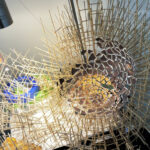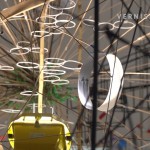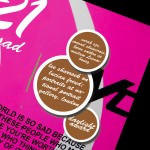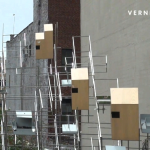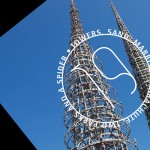The Musée d’art moderne Grand-Duc Jean (Mudam) in Luxembourg opens the 2012 program with a series of new exhibitions ranging from painting and sculpture to design and fashion. One of the shows presents a new work by New York-based artist Sarah Sze. Sarah Sze is known for her complex sculptures and site-specific installations, for which she utilizes everyday objects such as tea bags, water bottles, light bulbs, and electric fans. Mudam has invited Sarah Sze to create a new installation specifically for the Museum Pavilion. The artwork is titled Fixed Points Finding a Home.
Sarah Sze was born in 1969 in Boston. She graduated from Yale University in 1991 and received a MFA from the School of Visual Arts in New York in 1997. Sze had solo projects at the Museum of Contemporary Art, Chicago, the Walker Art Center, Minneapolis, and the Institute of Contemporary Art in London. Her work has been exhibited in international venues such as the Venice Biennale, the Carnegie International, Pittsburgh, the Whitney Biennial, and the Sao Paolo Biennial. Sze is a 2003 John and Catherine T. MacArthur Fellow.
For New York’s High Line, she created a work that’s a sculpture as well as bird, butterfly and insect observatory, with perches, feeding spots and birdbaths (Still Life With Landscape). An exhibition that focuses specifically on Sarah Sze’s process (Infinite Line) is currently on display at the Asia Society, New York.
The exhibition at Mudam Luxembourg, curated by Marie-Noëlle Farcy runs from February 11 to September 16, 2012.
Sarah Sze: Fixed Points Finding a Home (2012). Installation at Mudam Luxembourg. Opening reception, January 10, 2012.
PS: See also: Sarah Sze: Still Life With Landscape (Model for a Habitat) / The High Line, New York.
> Right-click (Mac: ctrl-click) this link to download Quicktime video file.
Press release:
Over the past fifteen years, the New York artist Sarah Sze has single-mindedly created a body of work consisting mostly of large-scale, intricate installations. Her works, always specifically conceived for the exhibition venue in question, are for the most part made up of a huge variety of everyday objects. These, however, are by no means chosen at random, but selected with great precision on the basis of their formal qualities or, sometimes, their ambiguity. In addition to these ready-made objects, she also uses hand-made constructions made from “lowly” materials such as matches, thread or paper. These constructions, often seemingly arranged according to archi- val principles of order, give a coherent structure to the whole.
Sarah Sze’s works form open universes comprising an archaeological diversity of encyclopaedic dimensions. They possess the precision of architectural constructions, the formal and colouris- tic subtlety of pictorial compositions and the quality of spatial motion displayed by multifaceted sculptures. They achieve this by adding an almost musical dimension to the spatiotemporal process of each viewer’s individual perception. Moreover, Sarah Sze orchestrates an abundance of details into complex single motifs, visual melodies contrastive figures, formal counterpoints and an overall composition of airy monumentality. Inspired by Japanese-Chinese horticultural art, the artist creates visual landscapes of an abstract nature which are structured without any trace of hierarchy, yet still offer guidance to the gaze.
Sarah Sze’s works are often designed for display in intermediary places that attract little attention, such as stairwells, side corridors, corners or window niches. Sometimes hovering, and always light and playful, they ask general questions about scale: near and far, heavy and light. They ask questions about their own temporality, the effort involved in their production and their transient nature. Each individual work also interrogates the place in which it is exhibited and the (concrete and ideational) space of art that the viewers enter, often without noticing. Finally, the works involve the viewers in an intensive activity of seeing and challenge them to become aware of their own location and of their own gaze. While the complex structures of Sarah Sze’s instal- lations conceal an abstract reflection of her own personality, they also make the viewers more conscious of their own seeing, and thus of their own existence. Like gigantic scientific models
of elegant and meditative microcosms, the works of Sarah Sze seem to comment on our behav- ioural patterns and our relationship with our world.
Sarah Sze was born in 1969 in Boston. She lives and works in New York.

